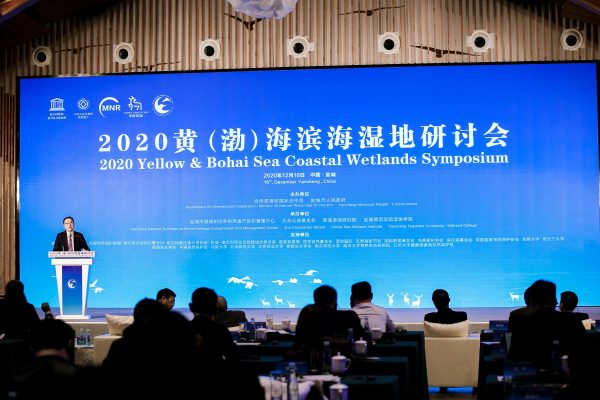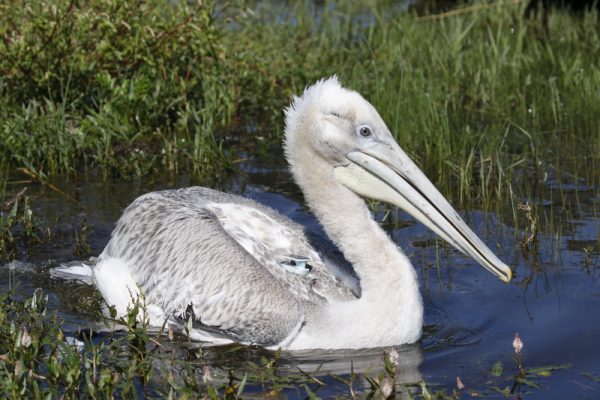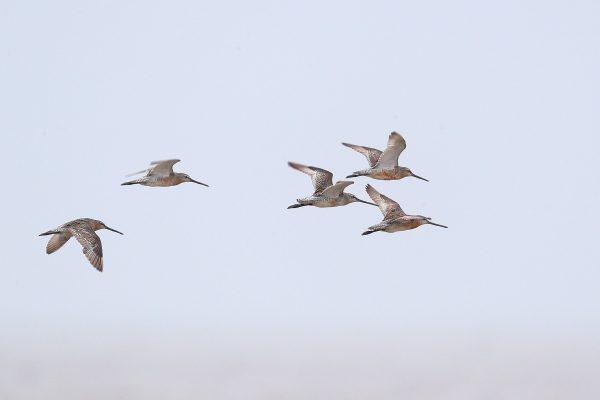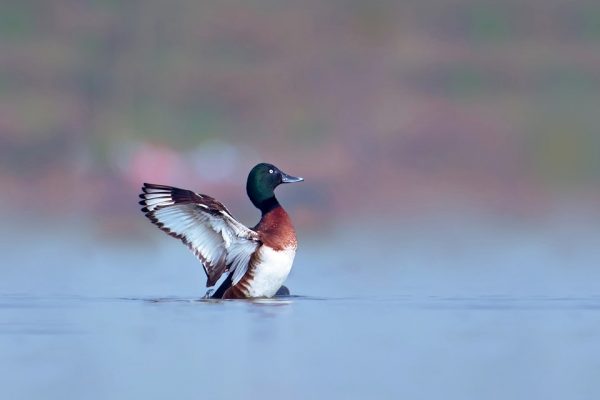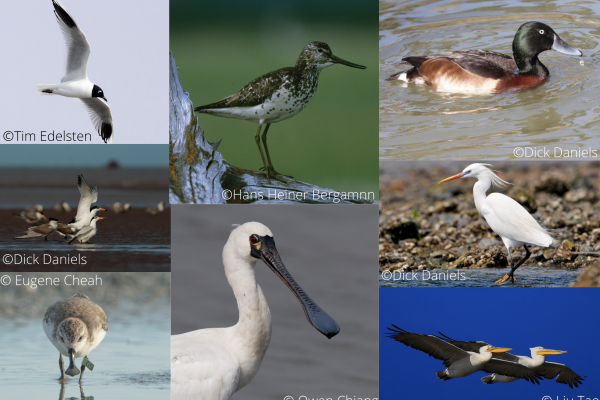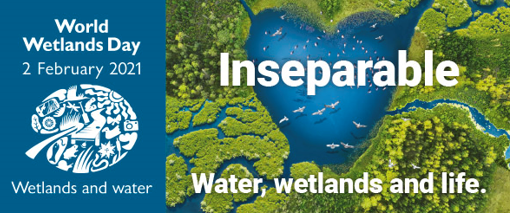-
Promoting the wise use of artificial wetland – fishponds in Hong Kong
Conserving the natural habitats is the priority for conservation in the field, but at sites where habitats had been modified and degraded, we should promote the restoration and wise…
Continue reading -
Some updates on colour legflags used in Southern China
Marking migratory waterbirds with metal rings, wing tags, neck bands, leg rings and flags, nasal discs, telemetry equipment like GPS devices, is an important way of studying their migration….
Continue reading -
2020 Yellow & Bohai Sea Coastal Wetlands Symposium and establishment of Yellow Sea Wetland Institute in China
Since the Coast of Yellow Sea-Bohai Gulf of China (Phase I) in Yancheng was inscribed in the as UNESCO’s Natural World Heritage site on 5th…
Continue reading -
More wintering Siberian Cranes in Guangdong Province, China
In winter 2019-2020, Guangdong Province in Southern China had the first record of nine Critically Endangered Siberian Crane in Jiangmen City. This January, a flock of 11 Siberian Crane…
Continue reading -
First GPS tracking study of the Dalmatian Pelican in East Asia
After several years of careful planning, Mongolian biologists captured and color-banded 13 juvenile Dalmatian Pelicans at Khar Us Lake National Park (Flyway Network Site EAAF 128) in August 2020. Because the population situation is too fragile due to its extremely low number, we sought various advice about the methods and tools that can be used to capture and mark them. We invited experts from Greece and Russia with field experiences in handling and marking pelicans and asked for practical advice before we lay hands on pelicans. Juvenile Dalmatian Pelicans © Nyambayar Batbayar/ WSCC of Mongolia In addition to alphanumeric yellow color bands, which were donated by Society for the Protection of Prespa (SPP). We deployed two GSM GPS transmitters as backpack on the two biggest juveniles. Those two transmitters were donated by BirdsData, a Chinese GPS transmitter manufacturer. We were all excited. Thankfully the transmitters are working well to date despite having some difficulties to transmit the data on regular basis in the wintering area because of the frequent condition of having thick clouds. Migration of the first juvenile pelican started on 25th September and arrived at its final destination in Wenzhou Bay in East China on 8th January, after travelling over 4,200 km distance in 105 days. The second juvenile started its migration on 2nd October and arrived at the same place on 8th December after travelling over 3,800 km in 62 days. They used similar routes and made 14-15 stops during this migration. Both birds flew between stopovers on an average 5-9 hours from the morning till the evening until they reach a night roost. It seems their successful migration highly depends on available night time roosts during this long journey. We were astonished by seeing both birds have roosted on open steppe area in the middle of Gobi desert, most likely an area without open water. One of these dry roosts was even located in the middle of a busy road. High precision GPS tracks of one bird showed that it walked about 17 km after it landed on an open area and changed its locations three times on that night. It must have been hard for the pelicans to spend the night on such dry roosts. Fortunately, both birds spent the nights safely and continued their migration next day without any incident. Migration route of two juvenile Dalmatian Pelican with GSM GPS transmitters © Nyambayar Batbayar/ WSCC of Mongolia Compared to populations in other parts of the range, Dalmatian pelicans in East Asia make the longest migration. The tracking data showed that the two tagged pelicans made regular daily stops when flying through Mongolia until they reached their first stopover site in China. We were relieved when birds safely arrived at Yellow River in Inner Mongolia, because it is the largest open water where the pelicans rested since they left Orog and Boontsagaan Lake in Mongolia, which is over 1,000 km distance. Once birds reached China, the number of wetlands where they can rest seems to be more abundant. However, the birds also seem to be quite picky when choosing stopover sites. At the moment, we are not completely sure what makes them choose one site over another. We will need more tracking data to draw some meaningful conclusions about their stopover site selection. Two pelicans stopped at several locations along the east coast of China such as Beidagang Reservoir, Yellow River Delta, Haizhou Bay, Zhonglu Harbor, Daiyugang outflow, Yangze River, Hangzhou Bay, Taizhou Bay, and Wenzhou Bay. They all seem to be extremely important for Dalmatian Pelicans to successfully continue their migration. It is crucial to ensure the connectivity of these sites to sustain their migration. Since the two tagged pelicans arrived in China, birdwatchers and conservationists in China are helping us to report the location and number of pelicans. We appreciate their help very much, because they are making really important contributions for the conservation of the pelican. The sharing of inforamtion help the researchers to understand more about the species and the causes of their decline. The latest report from the Wenzhou Bay came 2 days ago saying the pelicans might have started heading back to the north. This migration study was a part of the joint conservation efforts by the East Asia-Australasian Flyway Partnership’s Dalmatian Pelican Task Force. The goal of the Dalmatian Pelican Task Force is to restore the East Asian population of Dalmatian Pelican to a positive growth rate for a period of at least three generations. We cannot accomplish this goal alone, we need help from everyone who cares for this giant yet beautiful bird. Article prepared by Nyambayar Batbayar and Batmunkh Davaasuren, Wildlife Science and Conservation Center of Mongolia Taking body measurement of the juvenile Dalmatian Pelican in Mongolia © Nyambayar Batbayar/ WSCC of Mongolia
Continue reading -
Lianyungang, an important yet overlooked stopover site in the southern Yellow Sea
A Dalmatian Pelican is making Lianyungang pancakes for an Asian Dowitcher, a Eurasian Oystercatcher and an Ancient Murrelet. All four birds rely on Lianyungang during their annual migration. Illustrator © Nemo. Over the past few decades, people have come to realise that tidal flats along the Yellow Sea-Bohai Bay are of paramount importance to migratory shorebirds along the East-Asian Australasian Flyway (hereafter EAAF). For example, several sites along the southern Jiangsu province of China have been recognised as the critical staging ground for globally endangered shorebirds such as the Spoon-billed Sandpiper and Nordmann’s Greenshank. The improving awareness and knowledge were followed by varying degrees of conservation efforts. The most successful story was probably Tiaozini, the most important stopover site for Spoon-billed Sandpipers. In 2019, Tiaozini was included in the scope of natural World Heritage Site, which is the highest level of habitat protection and conservation in China. Unfortunately, sites without stable records of charismatic species like the Spoon-billed Sandpiper has been given little attention. Lianyungang, a long-overlooked coastal jewel Lianyungang is a coastal city located in northeastern Jiangsu. With the Yellow Sea on its east, Lianyungang is roughly 300km north of Tiaozini. There are over ten major estuaries along its 212km coastline, creating vast areas of coastal tidal flats. Probably due to the lack of charismatic species, Lianyungang has been largely overlooked. Waterbird surveys in this area had mostly been conducted by a single volunteer in the past decade, meaning that temporal and spatial coverage were often limited. During May 09-13, 2019, a non-profit organisation called Spoon-billed Sandpiper in China (hereafter SBSinChina) recruited ten experienced surveyors in an effort to conduct a comprehensive waterbird survey in Lianyungang. They found that significant numbers of several shorebird species rely heavily on the Lianyungang coast during northward migration. Locations of the major survey sites, as well as the location of Lianyungang on the east China coast (inset map). Solid lines and dashed lines represent the area of tidal flat and high-tide roost surveyed during May 09-13, 2019. Credit: Google map. Important findings in Lianyungang During the five-day survey, SBSinChina recorded 30 species of 109,028 shorebirds. On May 12, 2019, over 22,432 Asian Dowitchers were recorded at the Qingkouhe tidal flat, which constitutes 97.5% of Asian Dowitchers’ global population estimate. This is by far the highest number of Asian Dowitchers recorded at a single site. The high concentration of Asian Dowitchers at Qingkouhe tidal flat, Lianyungang on May 12, 2019 © Ziyou Yang. Over 3,500 Black-tailed Godwits was recorded on the Xingzhuanghe tidal flat on May 10, 2019, which constitutes 2.2% of its estimated global population. During the five-day survey, the surveyors observed 41 individually flagged Black-tailed Godwits, of which 38 were recorded on the Xingzhuanghe tidal flat. Among those flagged individuals, most were only previously observed at Broome, Western Australia, so the survey results filled a gap in the species’ stopover site and migration strategy. Some of the individually-flagged Black-tailed Godwits recorded on the Xingzhuanghe tidal flat during May 09-13, 2019 © Yongxiang Han. Several other shorebird species, such as Lesser Sandplovers (15.6% of EAAF population), Sharp-tailed Sandpipers (6.9%) and Broad-billed Sandpipers (5.5%) were also recorded in significant numbers on the Lianyungang coast. More details can be found in the 32nd issue of BirdingAsia. It’s no coincidence! SBSinChina’s survey results suggested that Lianyungang is the most important stopover site for Asian Dowitchers during northward migration. In autumn 2019 and spring 2020, SBSinChina carried out additional surveys on the Lianyungang coast. They confirmed that the record-breaking number of Asian Dowitchers observed in spring 2019 was not a coincidence, because over 20,000 individuals were recorded in Lianyungang exactly one year later. They also discovered that Lianyungang is crucial to Asian Dowitchers and some other shorebird species during southward migration, supporting at least 28.5% Asian Dowitchers, 6.6% Black-tailed godwits and 5.1% Great Knots on a single day in August 2020. An elegant Asian Dowitcher in Lianyungang © Zhenhong Hu. Asian Dowitchers were flying above the Qingkouhe tidal flat © Zhenhong Hu. Conservation Implications While the discovery of a critical stopover site is exciting, when the majority of Asian Dowitchers aggregate at one single site during northward migration, they become very susceptible to human activities and/or stochastic events. Currently, the conservation status of Asian Dowitcher is Near Threatened. Although comprehensive, long-term monitoring data is lacking, SBSinChina suspects that the population of Asian Dowitchers may have declined. Given its highly concentrated distribution and suspected decrease in population, the conservation status of Asian Dowitchers may need re-assessment by the IUCN committee to warrant timely conservation of the species. SBSinChina is currently gathering data to reassess the population and distribution of Asian Dowitchers in China and beyond. Although Lianyungang does not boast charismatic species like Tiaozini, it does support significant numbers of other shorebirds that are key components of ecosystems along the EAAF. Currently, coastal wetlands on the Lianyungang coast are largely unprotected. Shorebirds still face multiple threats including tourism development, Spartina invasion and lack of suitable high-tide roosts. The indifferent attitude adopted by the local government towards conservation is not helping. The aerial view of the Blue Bay tourism development project near Linhonghe tidal flat © Dihai Chen. Based on the survey results, SBSinChina recommends that survey efforts should be continued in Lianyungang to inform conservation and management actions. They also suggest that key stakeholders work together to include Lianyungang in phase II of the serial natural World Heritage nomination. Together with other sites along the Yellow Sea-Bohai Bay coast, Lianyungang can provide rich ecosystems to serve both migratory waterbirds and local communities. Article link: https://www.orientalbirdclub.org/birdingasia-32 Prepared by Yang Ziyou from Spoon-billed Sandpiper in China.
Continue reading -
New protection for Baer’s Pochard in China
ⓒ Luo Jianhong On 5th February 2021, the Chinese State Forestry and Grassland Administration announced a crucially important revision of the list of national wildlife under special protection. Approved by the State Council on 4th January 2021, this is the first revision since the original list was published in 1988. It provides very welcome additional protection for a number of threatened waterbirds, including, for the first time, Baer’s Pochard, which is now afforded the highest level of protection (Class I). Previously this species was not included on either the Class I or Class II lists due to its relatively secure conservation status in the 1980s. Whilst most wild birds in China are protected, Class I protection provides stricter levels of punishment, including significant fines and the potential for custodial sentences, for anyone harming these priority species or, crucially, their habitats. For Baer’s Pochard this is significant, as wetland loss and degradation is a major driver of the decline and remains an important issue going forwards as we work to recover its population. An important part of this recovery work is undoubtedly the protection and sensitive management of all sites supporting Baer’s Pochard, whether during the breeding, non-breeding or migration periods. This ecologically sensitive management (the wise use principle enshrined in the Ramsar Convention on Wetlands) also needs to extend to other wetlands within the distribution of Baer’s Pochard with the potential to support the species and to sites where wetland restoration is underway, in order that the small and fragmented population we have today can flourish. This revision of the wildlife under special protection therefore provides a strong foundation for the wetland protection from which we can recover Baer’s Pochard and its wetland home for future generations. The Baer’s Pochard Task Force extends its warm thanks and appreciation to all who contributed to the completion of this important revision. Prepared by Baer’s Pochard Task Force on 10th February 2021
Continue reading -
What does the revised China Protected Species list mean for EAAFP?
February 5th, the Chinese government announced the publication of…
Continue reading -
2021 World Wetlands Day: Restore our wetlands in the East Asian-Australasian Flyway
World Wetlands Day, celebrated every year on 2 February, to raise global awareness of the importance of…
Continue reading -
Launch of the Coordinated survey in middle and lower reaches of Yangtze River 2020/2021
The extensive wetlands of the middle and lower reaches of Yangtze River are critical to the function of the whole Yangtze ecosystem, which in turn provides essential services to…
Continue reading



